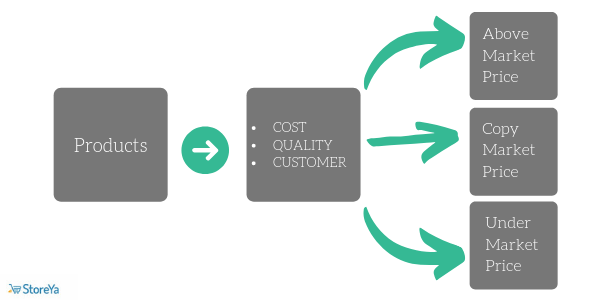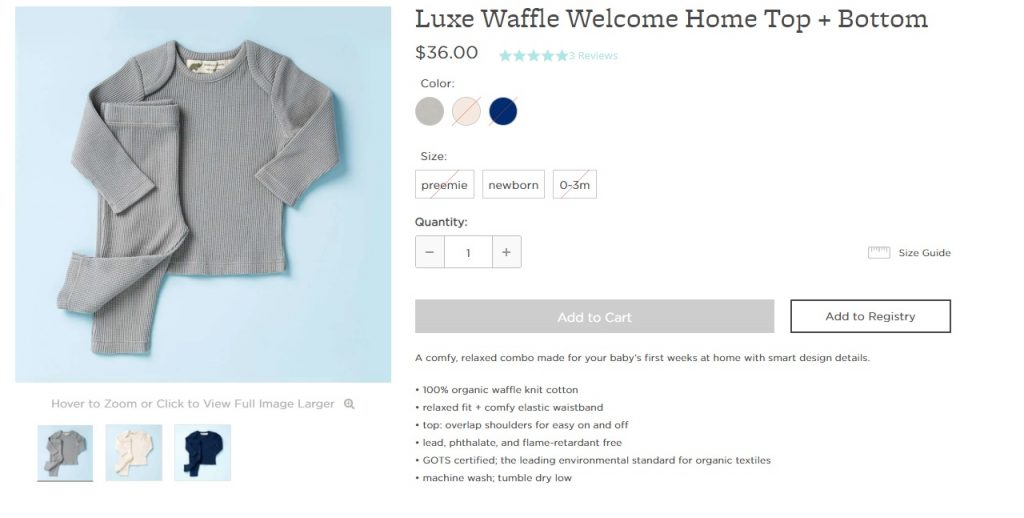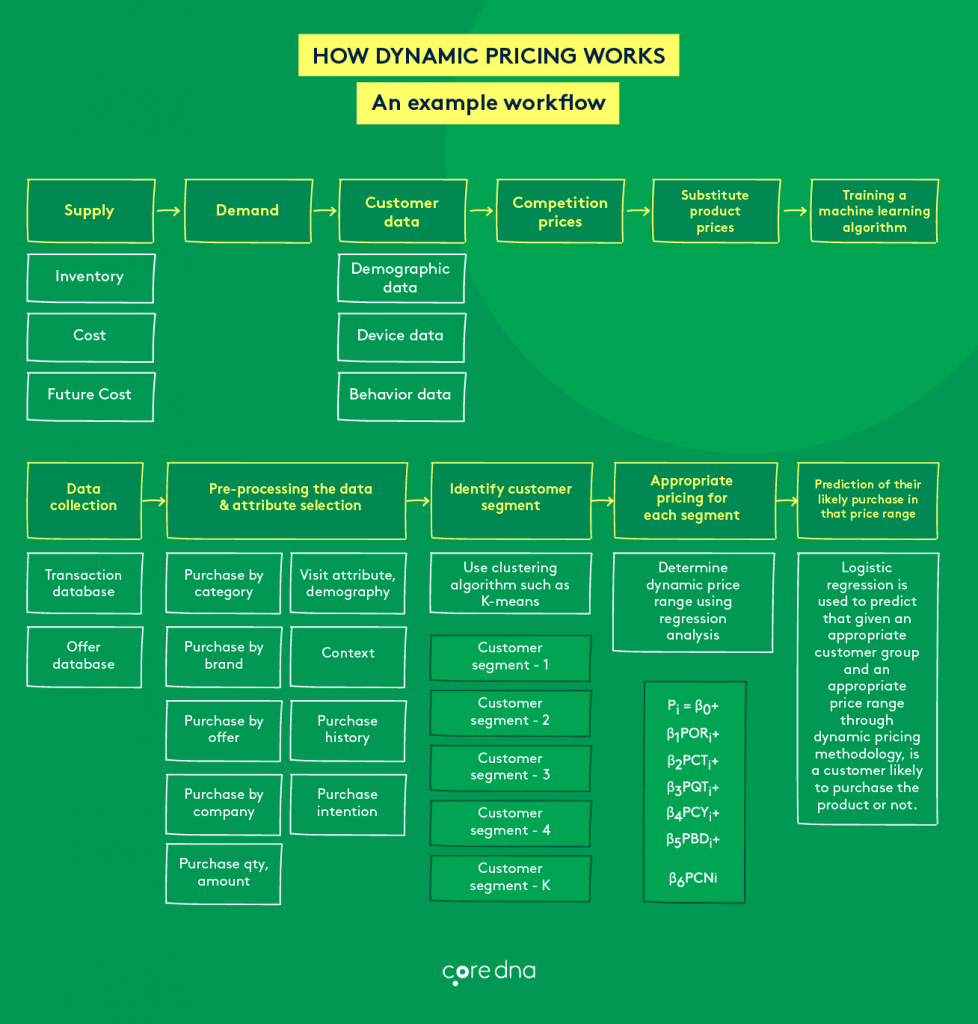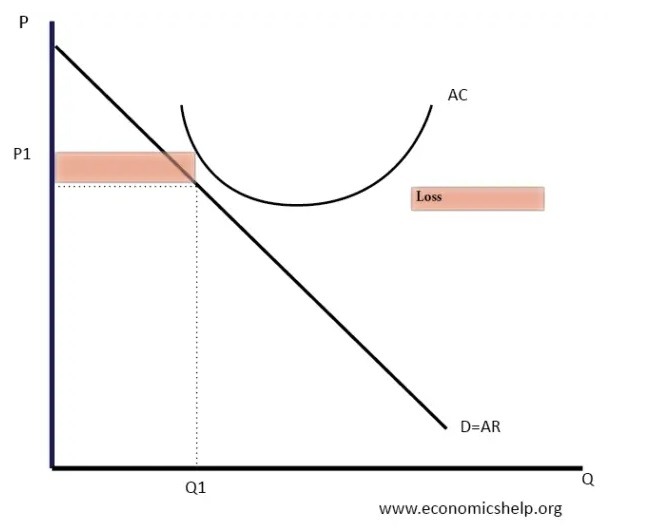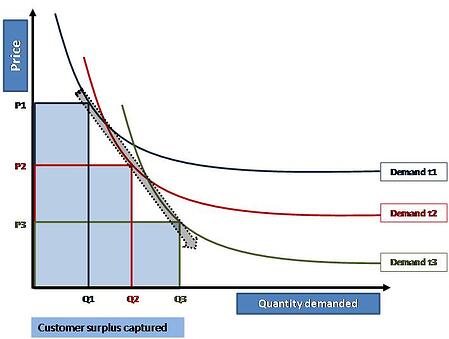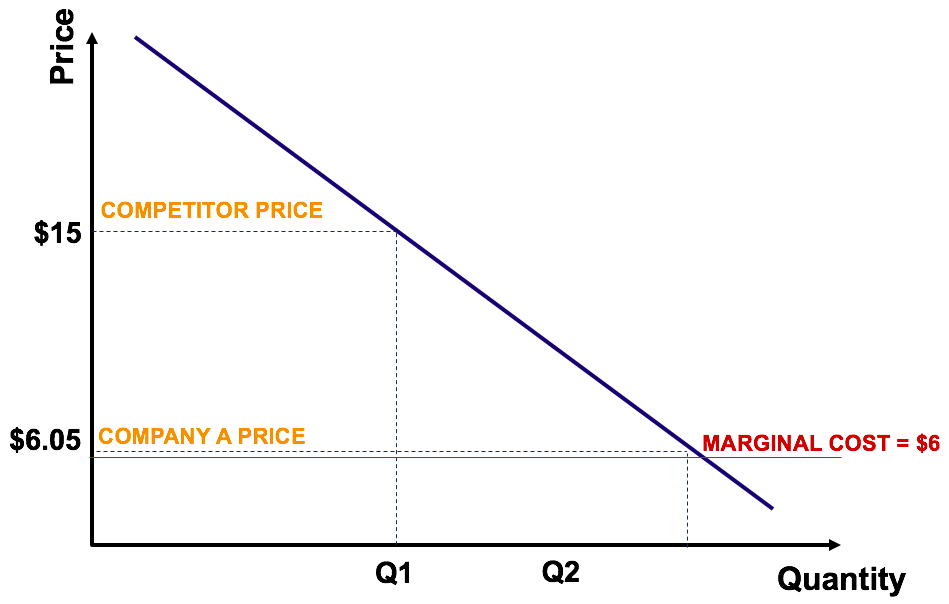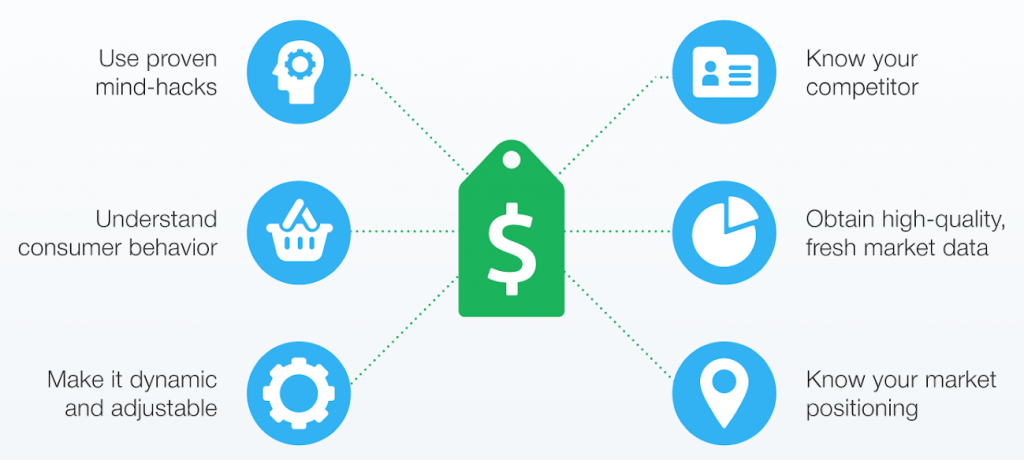Finding the most effective product price can be a tricky affair, but it’s also incredibly important to the success of your online store in cutthroat niches, which is where competitive pricing strategies for eCommerce come in.
The right pricing strategy will ensure you are able to price your products correctly to ensure you are generating profits without under- or overpricing yourself out of your niche. It should be based on your market, competition, costs, marketing sales funnel, or a combination of all of these to ensure you are pricing your products so that you are not destroying your margins or pricing yourself out of a sale.
What is an eCommerce Pricing Strategy?
An eCommerce pricing strategy is a set of rules or methods you should use to price your products. These can be as simplistic as cost-based strategies, where you take the cost of production and add your designed margin on top of the costs, or as involved as valued-pricing, which focuses on the perceived value of a product to your customers.
In short, when it comes to competitive pricing strategies for eCommerce, the ultimate goal is to increase conversions without sacrificing your profit margins. This can be a complex process for even the most experienced sellers. Still, if you really want to succeed here, you need to create a pricing strategy unique to your business, niche, and market, and be ready to adapt strategies at a product-, category-, and niche-level, depending on dynamic market changes.
Bonus Content: eCommerce Conversion Rates Per Niche [2021 Benchmarks]
To help you do just that, we’ve put together this comprehensive list of competitive pricing strategies for eCommerce covering basic, intermediate and expert strategies that you can test and adapt to find your conversion sweet spot. For those of you with an established online store, you can skip through to our intermediate competitive pricing strategies for eCommerce here.
Basic Pricing Strategies for eCommerce
1. Cost-Based Pricing [Beginner]
Cost-based eCommerce pricing is the most straightforward pricing strategy. As the name suggests, this pricing strategy takes the cost of each product and adds the markup percentage on top of that. This is a popular choice for new online sellers, as it only has two variables to consider here: what a product costs you to make, advertise and fulfill, and the profit you would like to make on that product.
It’s important to note here that you need to be analyzing the break-even point for your business and considering all cost implications, including everything from your website hosting to warehousing, apps or software you’re using, and freelance salaries.
How Does eCommerce Cost-Based Pricing Strategies Work?
Let’s say you have a POD eCommerce business model and are only selling one type of print-on-demand product: t-shirts. And let’s assume the cost of the t-shirt is $7.10. You would then take the production cost of the t-shirt from your supplier – plus other business costs, such as marketing, rentals, Shopify apps, etc. – to get the true cost. For this example, let’s say the total cost would then be $12.00 after including supplier and other business and marketing costs, like Facebook ads.
Bonus Content: The Best Way to Market Your Print-on-Demand T-Shirt Business
You will need to decide how much profit over and above that you will want to make for each t-shirt sale. If you’re a brand-new store looking to break into a competitive niche, you could start with a sales price of $15, making a $3 profit per sale, and see how the market reacts.
eCommerce Cost-Based Strategy Advantages
- Ideal for beginners, this pricing strategy is very simple to research and implement.
- Additionally, for those with minimal marketing budget without much leeway, this will help ensure you can stick to your budgets while also having a clear idea of the profits you can earn for that spend.
eCommerce Cost-Based Strategy Disadvantages
- This pricing strategy focuses on what you want to earn, not what your customers are willing to pay, and is therefore too simplistic for long-term growth.
- If you want to stay ahead in the competitive eCommerce market, you will need to dig deeper in terms of pricing. This pricing strategy will not enable creativity required.
2. Market or Competition-Based Pricing [Beginner]
eCommerce market-based pricing strategies take the cost-based strategy a step further by incorporating your niche competitors. This is especially important if you’re selling in a niche such as electronics or homeware where you are selling identical or very similar products as other online stores, meaning customers have an opportunity to shop around.
The trick here is to either price yourself higher or lower than the average, depending on how you want your brand to be perceived in relation to your competitors, or if you’re a new or established seller.
How Does eCommerce Competition-Based Pricing Strategies Work?
To create this pricing strategy for your online store, you will need to research competitors who are selling very similar or the same products as you are in the markets you’re selling in. This should span high-end to budget stores to provide an in-depth analysis of your market.
Let’s say you are selling yoga gear and are looking to introduce yoga mats to your store. You’re not a new seller, but this is a new product category you’re offering from a brand that already has a good track record in terms of quality. Although the mats cost you $20 to produce and market, and the research revealed that the average price online for a yoga mat is $40, you may decide to start your pricing slightly above the market average – $45, giving you a $25 profit.
eCommerce Competition-Based Strategy Advantages
- This is the ideal eCommerce pricing strategy for those who want to keep your finger firmly on the pulse of what the market is doing to ensure you are on par.
- Ideal for newer sellers looking to upgrade their cost-based pricing strategy to something more robust.
eCommerce Competition-Based Strategy Disadvantages
- Competition-based strategies will require a lot more time and effort to get the balance just right.
- Building your entire pricing around your competitors – and ignoring your brand and customers –can be limiting, and you could find yourself in a race to the bottom with multiple brands slashing prices.
3. Bundle Pricing [Beginner & Intermediate]
Bundle pricing strategies are fairly simple to implement and involve offering a discounted price for a bundle of products when bought together. This strategy is particularly effective for products and accessories, such as selling matching workout tops and leggings or electronics such as a camera lens and a lens cap. In short, this is a great way to increase your average order values, and, if done correctly, can make the shopping experience easier for your customers.
How Does eCommerce Bundle Pricing Strategies Work?
As mentioned, bundle pricing strategies involve grouping products together and then offering a cheaper price for the grouping. There are several ways you can get creative with implementing bundle pricing strategies; here are a few to give you an idea of how you could implement them. You could bundle:
- Similar products and accessories
- Different brands together in one package
- Two products, where only one of them can be bought on their own (often referred to as mixed bundling)
- New products with unpopular products to boost the latter’s sales
- Products together that cannot be purchased on their own separately (such as a pajama top and bottom or some baby sets)
When using bundle pricing, it is vital that the bundle price is lower than the asking price for each individual product and the packages are easy to understand.
eCommerce Bundle Pricing Strategy Advantages
- Bundle pricing can increase average order values and increase customer satisfaction.
- Offers flexibility in terms of pricing creativity, allowing you to find combinations that work very well for your brand and shopper.
eCommerce Bundle Pricing Strategy Disadvantages
- Shoppers may not want or need all the products you have bundled together.
- There isn’t a one-size-fits-all approach to bundling. You will need to create and test bundles, and this can take time and energy.
Intermediate Pricing Strategies for eCommerce
4. Value-Based Pricing [Intermediate]
The next competitive pricing strategy we will look at is value-based pricing. This intermediate pricing strategy is a blend of cost and competition-based tactics and requires a deeper look into perceived customer value. Simply put, value-based pricing is about pricing your products in terms of how your customer sees your products and is best suited for those products that enlist an emotional experience.
Best suited for established eCommerce brands that already have a following and who are already known for quality within their niches, value-based pricing relies not just on your products but your whole sales funnel and your brand positioning.
How Does eCommerce Value-Based Pricing Strategies Work?
To come up with an optimum value for your products, you first need to know your break-even price: the lowest price you can sell your product at to cover production, business, and marketing costs. Then research as you would for a competition-based strategy to determine market averages, i.e., at what prices your competitors are selling similar products.
Let’s say you have an online legging store with a steadily increasing revenue and are looking to add a new type or design option to your store. And let’s assume the cost to produce and market your new design will be $40 – that’s your baseline price. After you analyze your competitor’s pricing, you get an average price of $50. This means that if you price your product at the average, you would be making $10 profit per sale.
However, your brand has a good track record and a perception of quality that exceeds the average store in your niche – this is where value-based pricing comes in. In this scenario, you may decide the price of your new legging design or style should exceed both your competitive and base-line pricing. Due to what you know about how customers value your products, you decide to sell your designs at the higher-end of the leggings niche, while also giving you room to offer sales discounts while still ensuring you are earning your products’ worth.
eCommerce Value-Based Strategy Advantages
- Value-based pricing is the perfect hybrid between what you want to earn on a sale and what your customers are willing to pay.
- Highlighting the emotional value of your products while building your brand perception leads to higher satisfaction and a more loyal customer base.
eCommerce Value-Based Strategy Disadvantages
- To truly succeed in a value-based strategy, you need to build trust and strengthen your brands to quantify value for customers.
- Remember, customers are only willing to pay what they believe they are worth. Therefore, this is a work in progress and will take tweaking to get right. It is not suited for newbie sellers or sellers whose product quality does not live up to expectation.
Think about it this way: iPhones are built around value-based strategies and a strong brand, but they wouldn’t be able to do that if the quality of Apple products didn’t hold up to the perception that is created.
Pro Tip: As part of your research, you will want to create buyer profiles for your audiences, grouping shoppers based on personas. This can include location, ages, gender and income stats, as well as more emotional data like business motivations and concerns. This way, you can ensure your marketing matches these data points, allowing you to add a higher value-based pricing structure.
5. Dynamic Pricing [Intermediate]
Dynamic pricing takes industry standards (competitor-based pricing), market conditions and shoppers’ expectations (value-based pricing) into account to continuously and dynamically adjust pricing in real-time. In simple terms, it is a flexible pricing strategy that enables online sellers to set optimal prices in response to real-time market changes, such as competition and demand changes.
To be able to use this strategy effectively, it is highly suggested that you invest in eCommerce tools, such as repricing apps, to ensure you can run these changes on auto-pilot, especially if you have a more extensive inventory.
How Does eCommerce Dynamic Pricing Strategies Work?
With dynamic pricing, you are collecting and using competition, customer and industry data continuously and then using data points in analytics to adjust your product prices. This is a complex strategy, and it’s not just about automatically lowering your price to one-up your competition. It’s about assessing all the variables to find the optimum price for your product in the here and now.
In other words, dynamic pricing should incorporate a variety of pricing strategies such as peak-demand and time-based pricing, where you adjust to seasonal changes, such as selling winter coats in winter versus summer, or dynamically increasing value-based pricing as popularity for a new product increases. The point is, it takes a lot of data, but if done right can be very effective. Here’s just one example of a possible workflow for dynamic pricing from Core dna.
Pro Tip: Pairing dynamic pricing with your sales and discounts strategy can be hugely successful. Here, instead of running the risk of two customers finding out that they paid two different asking prices, you can instead use dynamic pricing to set your ‘sale’ prices, thus leaving your asking prices the same for all customers.
eCommerce Dynamic Pricing Strategy Advantages
- Because this pricing strategy allows for quick, dynamic shifts in the market, it enables you to maximize profit potential in real-time.
- This strategy gives you control over price positioning, flexibility around revenue and profits, and gives you valuable audience segmentation data you can use for other strategies or new product pricing.
eCommerce Dynamic Pricing Strategy Disadvantages
- This is a complex strategy, to make the most of it, invest in the right tools and dedicate a person to assess data and make necessary changes.
- If you opt for complete auto-pilot mode, where you only rely on a repricing tool to match or better a competitor’s price (without all the other variants mentioned), you could find yourself in a bidding war to the lowest pricing, which can kill your profits.
6. Discrimination Pricing Strategies [Intermediate]
Somewhat unorthodox, the discrimination eCommerce pricing strategy is where you would apply different prices for the same product based on who the buyer is or where they are shopping. Also sometimes referred to as segmented pricing, this strategy requires a combination of dynamic and value-based pricing practices, with segmentation relying on cost parameters and perceived value.
How Does eCommerce Discrimination Pricing Strategies Work?
Let’s say you have an online pet store and are selling a dog bowl for $10. During your value-based research, you have discovered a group of shoppers who would be willing to pay $15 for that product, costing you $5 per sale in earning potential. However, you have another segment of shoppers who shop from a different location or on another channel, who, when you increase the price to $15, stop buying your product, i.e., your conversion rates drop.
So, what can you do? With discrimination pricing, you could charge one group $15 and the other group $10 for the same product. There are many ways you could group shoppers and potential customers for segmentation pricing; here are a few to get you started.
Segment shoppers by:
- Geographical locations; grouping customers by region, area or country.
Pro Tip: If you offer free shipping and want to expand into new international markets, which will mean higher shipping costs, price discrimination enables you to adjust the price for higher costs in those specific areas.
- Channel they are shopping and buying on. Different channels will have different market values, competition levels, buyer income averages, etc.
- Time of the purchase being made, such as automatically dropping prices for shoppers after Christmas (seasonally).
- Amount of products a shopper is purchasing (bulk discounting).
- Purchase history, allowing you to segment a price based on whether the buyer is a new or returning customer.
eCommerce Discrimination Pricing Strategy Advantages
- This kind of pricing can help you boost profits while also giving access to products to lower-income shoppers and helping boost demand overall.
eCommerce Discrimination Pricing Strategy Disadvantages
- This is not a strategy you can just set and ignore. This strategy is very specific and you should test to ensure it works for your business before implementing it. You will also need to keep a close eye on your business KPIs to ensure you’re on the right track and tweak where necessary.
- If customers ascertain they are paying more for a product than other shoppers, they will feel taken advantage of, so you need to be very careful with how you approach this strategy, as well as how you are marketing these products and prices.
7. Lead Generation Pricing Strategies [Intermediate]
Lead generation pricing is another unique pricing model that will only work for specific products usually selling in the B2B niche, whereby eCommerce stores have particular lead generation goals. This kind of pricing could be used in some cases where you offer a highly customizable product whereby price will be determined by the customizations a shopper needs.
Alternatively, you could also use this strategy for a future product launch, where you could exclude the price of a product before it launches and instead include a ‘Request Information’ button instead. Or use this strategy for any product you are offering where customization is involved.
In a nutshell, this pricing strategy is about excluding the price from your product page and instead encouraging potential customers to ask your sales team to get back to them with more information.
Pro Tip: On Shopify? There is a host of apps you can use to insert request quote buttons instead of prices, such as this “Get a Quote” Button app from Gravity Software.
How Does eCommerce Lead Generation Pricing Strategies Work?
Let’s say you are a B2B eCommerce business that offers customized office supplies and furniture packages that are tailored specifically for each customer. Instead of then displaying an average price, you would outline the product and put a ‘Request Info’ button. After which your sales team could phone the manager back, or you could include a contact number or email for shoppers to request a quote.
eCommerce Lead Generation Pricing Strategy Advantages
- For customized products, lead generation pricing helps you engage directly with potential customers.
eCommerce Lead Generation Pricing Strategy Disadvantages
- This is a very niche pricing strategy and will only work in specific cases where the price is determined by the choices each shopper makes.
8. Price-Skimming Pricing Strategies [Intermediate]
Next on our list of competitive pricing strategies for eCommerce is price skimming. A price- skimming strategy involves setting a high price when launching a product and then decreasing the price over time. A good example of price skimming in practice is tech products.
Think of a new iPhone. At launch time, Apple sets the price high, but over time, as demand decreases and new products are introduced, the price of the phone decreases. Another example of this would be apparel brands, where new releases are put on at their highest full price. As demand decreases and seasons change, they are lowered into ‘bargain-bin’ and sales pages.
How Does eCommerce Pricing-Skimming Strategies Work?
When a new product is launched and marketed as a must-have, it’s at its highest perceived value. Over time, as demand decreases, the price is lowered to attract those customers who are more price-sensitive, ‘skimming’ customers from each segment along the way. It will look a little something like this:
eCommerce Price-Skimming Strategy Advantages
- Charging more at launch time when a product is high in demand and also highly valued means you have an increased chance of higher ROAS, while also maintaining the perceived value of your brand.
- Price skimming is another way you can segment your customers and gather valuable customer data that you can use for pricing on future products.
eCommerce Price-Skimming Strategy Disadvantages
- Price-skimming is only worth testing if you already have a highly established brand; a brand that is already viewed as a quality brand and your market isn’t overcrowded.
- If you don’t want to alienate early shoppers, you need a well-thought-out strategy that gradually tapers with the curve.
Expert Pricing Strategies for eCommerce
9. Penetration-Pricing Strategy [Expert]
This competitive pricing strategy is ideal for established eCommerce sellers looking to launch a new product or a new eCommerce brand that has an available launch budget to take profit knock. At the same time, they grow dominance in a highly saturated market or niche. In a nutshell, penetration pricing is where a seller will launch a product at a below-average price to quickly gain dominance over established competitors in their niche – sacrificing market share for profit. A good example of big brands that have built their brands on penetration pricing is Amazon and Netflix.
How Does eCommerce Penetration-Pricing Strategies Work?
Very simply, a penetration-pricing strategy involves market research to determine the average price of your competitor’s products and launching yours with a lower-than-average price until popularity and demand grows. You would then slowly hike up your prices and increase profit margins as your brand and product value increase, and gaining a big share of the market.
Penetration pricing can be used in conjunction with other competitive pricing strategies to help you get an influx of customers for a new product while building and maintaining your brand value. If you’re launching a brand-new online store, while offering phenomenal service throughout the shopping journey, and you’ll improve brand loyalty quicker.
eCommerce Penetration Pricing Strategy Advantages
- Penetration pricing allows you to boost your sales volume while you are still building a brand name or gaining market share in a highly competitive niche.
- You are able to more quickly attract new shoppers and build loyalty while offering highly competitive pricing.
eCommerce Penetration Pricing Strategy Disadvantages
- In marketing and implementation, you will have to make sure that potential customers don’t get the impression that your prices equate to low quality or this will do more bad than good to your brand image.
- You will need to be able to budget for lower profit earnings while you establish your new product or brand.
10. Loss Leader Pricing Strategy for eCommerce [Expert]
Loss leader pricing strategies take penetration pricing to the next level by not only dropping your price below market averages, but actually selling products at a loss. A brand would use this pricing either as above, to grow market share in a saturated market, or when they have a product that they can afford to make a loss on, as they have other product accessories with higher profits to offset.
For the latter use, let’s use an example of a printer brand. The printer company may sell their printer for less than production costs on a crazy sale, knowing they will offset this loss by the mark-up they have on their more consumable products, such as ink and paper.
Another brilliant example of loss leader pricing strategies are Black Friday retail sales. A brand uses a loss lender product at a considerable discount to get people onto their website or in their stores for Black Friday, and then strategically upsell other product options.
Although traditionally used by retailers, this is proving to be a competitive pricing strategy for eCommerce, and more and more brands are implementing it.
How Does eCommerce Loss Leader Pricing Strategies Work?
The goal here is to entice potential buyers onto your store by offering huge discounts. Simply put, you price your products below cost as a way to break through a saturated market or more quickly attract new buyers to your store. This means you can use loss leader pricing strategies on specific products or in your online promotions. Here’s one example of it in practice from Sumo, where they used loss leader coupons to grow their mailing list, resulting in an 8.49% conversion rate using a simple coupon mail popup.
eCommerce Loss Leader Pricing Strategy Advantages
- Most significantly, it enables you to break into a new market quite quickly, which makes it ideal for new eCommerce brands or established brands adding a product to a highly competitive niche.
- Helps you drive traffic to your store, where you can use your customer experience, value proposition and great product selections to engage with shoppers and grow loyalty.
eCommerce Loss Leader Pricing Strategy Disadvantages
- Attracting cherry-picker customers, those shoppers who value price over quality and only buy discounted products. This does not help with long-term brand growth.
- If you are not an established brand with a disposable budget that can handle the financial loss, this is not the pricing strategy for you.
- Loss leader pricing has been banned in a few states as well as abroad, so check the legal ramifications of this pricing strategy in every country you sell in before proceeding.
Conclusion: Creating Your Own Pricing Strategy [Expert]
There is no cookie-cutter solution when it comes to a competitive pricing strategy for eCommerce. If you truly want an optimum strategy that builds brand loyalty and trust while also increasing sales volume and profit, you’re going to have to test all these pricing strategies and build a hybrid that works for you.
To do this, you will need to have a deep understanding of your potential shoppers and customers, as well as your competitors. You will also need to have your finger on the pulse of your niche market and be ready to make adjustments dynamically.
Here are five steps to get you started:
-
Determine and outline your business goals. Are your goals to increase profits, to advance your market dominance, increase order values per customer, reach a new segment or market or launch a new product?
-
Conduct an in-depth analysis of pricing in your market. This will enable you to get an extensive look into the context of the market in which your brand or product will compete in.
-
Analyze your target shopper. Who will buy your product and why? What will they buy and how will they use it?
-
Assess your biggest competition, at least the five closest brands. What pricing structures are they using? Are they setting high-value prices but offsetting these with big discounts and regular sales? Are they bundling products or selling at below-market averages?
-
Select which competitive pricing strategies you will be using for your online store, based on the explanations above. If you’re a new store in a relatively quiet market with a limited budget, perhaps try cost-based pricing while building brand value. Or if you have the budget and you are entering into a very competitive niche, you may want to start with value-based pricing but run a price skimming launch sale to break into the market.
The possibilities are truly endless, and if you want to stay competitive, you’re going to have to get creative. In fact, here are some less-known, more novel pricing strategies you can also add to your short-list when creating your own pricing strategy:
- ‘Pay-what-you-want pricing’ will let shoppers set the prices they want to pay. An excellent example of where this is growing in popularity is in the service-based eCommerce market, where service providers like yoga teachers or life coaches are offering exclusive digital content on a ‘donate-what-you-can-afford’ basis.
- Flat pricing, where almost all your products are the same price. Think of your local dollar store, where everything is around the same price. Think micro sales! The idea here is that some projects will have high profits and some low, but if you concentrate on volume, there is earning potential.
Still got questions about pricing? Drop them in the comments below, and I will work through it with you!

Nicole is a content writer with over sixteen years experience and flair for storytelling. She runs on a healthy dose of caffeine and enthusiasm. When she's not researching the next content trend or creating business content strategies, she's an avid beachgoer, coffee shop junkie and hangs out on LinkedIn.
Recommended articles
 Facebook Ads for eCommerce: 16 Strategies, Examples & Tips
Facebook Ads for eCommerce: 16 Strategies, Examples & Tips
 How to Build a Winning eCommerce Ads Strategy
How to Build a Winning eCommerce Ads Strategy
 Google Ads for eCommerce: Everything You Need to Know
Google Ads for eCommerce: Everything You Need to Know
 10X Your Traffic with PPC Management Software
10X Your Traffic with PPC Management Software
Comments
Powered by Facebook Comments

